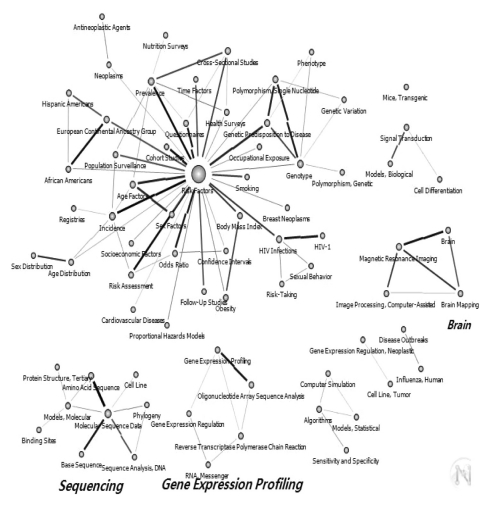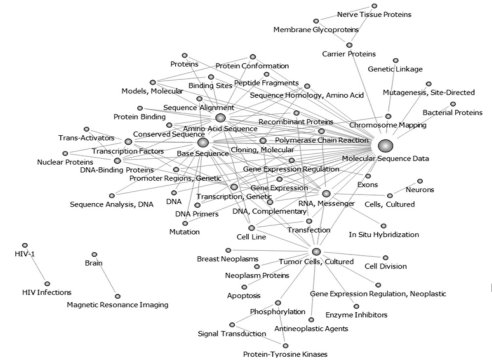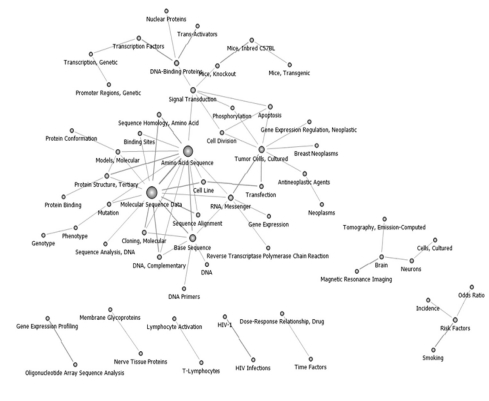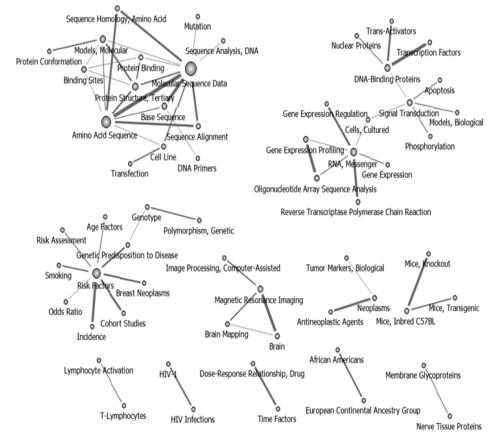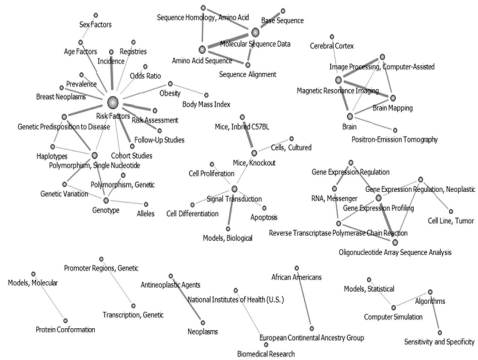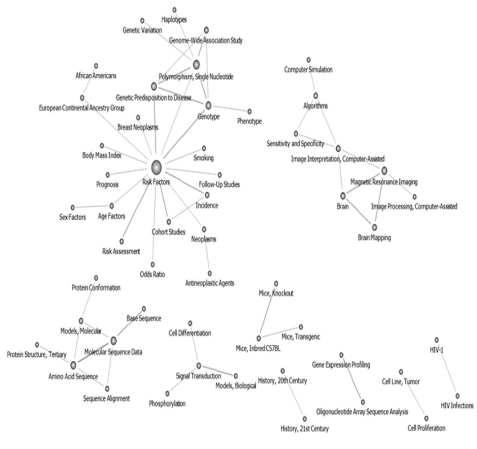1. National Academy of Medicine of Korea. Korean Medical Research Report 2006. 2007. Seoul, Korea: National Academy of Medicine of Korea; p. 15.

2. Synnestvedt MB, Chen C, Holmes JH. CiteSpace II: visualization and knowledge discovery in bibliographic databases. AMIA Annu Symp Proc 2005;724-728. PMID:
16779135.



3. Bernstam EV, Herskovic JR, Aphinyanaphongs Y, Aliferis CF, Sriram MG, Hersh WR. Using citation data to improve retrieval from MEDLINE. J Am Med Inform Assoc 2006;13:96-105. PMID:
16221938.



4. Jang HR, Kang GW, Lee YS, Tak YJ. An analysis of medical articles published domestically and abroad by Korean researchers from 1960 to 2008. J Korean Soc Libr Inf Sci 2011;45:259-277.

5. He Q. Knowledge discovery through co-word analysis. Libr Trends 1999;48:133-159.

6. Mane KK, Borner K. Mapping topics and topic bursts in PNAS. Proc Natl Acad Sci U S A 2004;101(Suppl 1):5287-5290. PMID:
14978278.



7. Jung M, Chung D. Co-author and keyword networks and their clustering appearance in preventive medicine fields in Korea: analysis of papers in the Journal of Preventive Medicine and Public Health, 1991-2006. J Prev Med Public Health 2008;41:1-9. PMID:
18250599.


8. Jung M. Academic research activities and their co-author and keyword network in epidemiology fields: analysis of papers in the Korean Journal of Epidemiology, 1991-2006. Korean J Epidemiol 2008;30:60-72.

9. Kang JO, Park SH. Analysis of scientific publication networks among medical schools in Korea. Healthc Inform Res 2010;16:100-119. PMID:
21818430.



10. Jeong S, Lee SK, Kim HG. Knowledge structure of Korean medical informatics: a social network analysis of articles in journal and proceedings. Healthc Inform Res 2010;16:52-59. PMID:
21818424.



11. Lee SK, Jeong S, Kim HG, Yom YH. A social network analysis of research topics in Korean nursing science. J Korean Acad Nurs 2011;41:623-632. PMID:
22143211.


12. Lee YS. Research network analysis for the national science knowledge map. 2010. Seoul, Korea: Korea Research Council of Fundamental Science and Technology.

13. Sohn DK. Generation and analysis of the research network for colorectal neoplasms dissertation. 2011. Cheongju, Korea: Chungbuk National University.

14. Price DD. The pattern of bibliographic references indicates the nature of the scientific research front. Science 1965;149:510-515. PMID:
14325149.


15. Small H. Co-citation in the scientific literature: a new measure of the relationship between two documents. J Am Soc Inf Sci 1973;24:265-269.

16. Chen C. Searching for intellectual turning points: progressive knowledge domain visualization. Proc Natl Acad Sci U S A 2004;101(Suppl 1):5303-5310. PMID:
14724295.



17. Callon M, Courtial JP, Laville F. Co-word analysis as a tool for describing the network of interactions between basic and technological research: the case of polymer chemistry. Scientometrics 1991;22:155-205.

18. Chung YM, Han JY. Mapping knowledge structure of science and technology based on university research domain analysis. J Korean Soc Inf Manage 2009;26:195-210.

19. Mane KK, Borner K. Mapping topics and topic bursts in PNAS. Proc Natl Acad Sci U S A 2004;101(Suppl 1):5287-5290. PMID:
14978278.



20. Garfield E. The history and meaning of the journal impact factor. JAMA 2006;295:90-93. PMID:
16391221.


21. Ding Y, Chowdhury GG, Foo S. Bibliometric cartography of information retrieval research by using co-word analysis. Inf Process Manag 2001;37:817-842.

22. Wang X, Wang J, Ma F, Hu C. The "Small-World" characteristic of author co-words network. Proceedings of the International Conference on WICOM. 2007. p. 3717-3720.

23. Van Raan AF, Tijssen RJ. The neural net of neural network research. Scientometrics 1993;26:169-192.

24. Zavaglia M, Canolty RT, Schofield TM, Leff AP, Ursino M, Knight RT, Penny WD. A dynamical pattern recognition model of gamma activity in auditory cortex. Neural Netw 2012;28:1-14. PMID:
22327049.



25. Coulter N, Monarch I, Konda S. Software engineering as seen through its research literature: a study in co-word analysis. J Am Soc Inf Sci 1998;49:1206-1223.

26. Coulter N, Monarch I, Suresh K, Marvin C. An evolutionary perspective of software engineering research through co-word analysis. 1996. Pittsburgh (PA): Carnegie-Mellon University Software Engineering Institute; Technical report no.: CMU/SEI-95-TR-019, ESCTR-95-019

27. Rip A, Courtial JP. Co-word maps of biotechnology: an example of cognitive. Scientometrics 1984;6:381-400.

28. Albert A, Granadino B, Plaza LM. Scientific and technological performance evaluation of the Spanish Council for Scientific Research (CSIC) in the field of Biotechnology. Scientometrics 2007;70:41-51.

29. Zheng HC, Yan L, Cui L, Guan YF, Takano Y. Mapping the history and current situation of research on John Cunningham virus - a bibliometric analysis. BMC Infect Dis 2009;9:28PMID:
19284593.



30. Kim SY. From MeSH indexed to retrieval. 2008. Seoul, Korea: Korean Medical Library Association.

31. Kwon AK, Chae YM. The study on subject words of Korean medical informatics by expanded MeSH: based on Journal of Korean Society of Medical Informatics. J Korean Soc Med Inform 2002;8:91-98.

32. Courtial JP. A coword analysis of scientometrics. Scientometrics 1994;31:251-260.

33. Lee WH, Kim YM, Park GR, Lee MH. A study on the emerging technology mapping through co-word analysis. Korean Manage Sci Rev 2006;23:77-93.

34. Kim P, Lee JY. Descriptor profiling for research domain analysis. J Korean Soc Inf Manage 2007;24:285-303.

35. Sohn DW. Social network analysis. 2010. 4th ed. Seoul, Korea: Kyungmun Publisher; p. 1-21.

36. Mika P. Social networks and the semantic web. 2007. New York (NY): Springer; p. 33-52.

37. Jung BS, Kwon YK. A study on the knowledge map of the computer engineering field by using a research paper database. Annu Proc Korea Inst Process Soc 2011;18:1460-1462.

38. Polanco X. Co-word analysis revisited: modelling co-word clusters in terms of graph theory. Proceedings of the 10th International Conference on Scientometrics and Informetrics. 2005. p. 662-663.

39. Kim YH. Social network analysis. 2007. 2nd ed. Seoul, Korea: Pakyoungsa.

41. Faust K. Comparing social networks: size, density, and local structure. Metodoloski zvezki 2006;3:185-216.

42. Borgatti SP. Centrality and network flow. Soc Networks 2005;27:55-71.

43. Freeman LC. Centrality in social networks conceptual clarification. Soc Networks 1979;1:215-239.

44. Lee JY. Centrality measures for bibliometric network analysis. J Korean Soc Libr Inf Sci 2006;40:191-214.

45. Opsahla T, Agneessensb F, Skvoretzc J. Node centrality in weighted networks: generalizing degree and shortest paths. Soc Networks 2010;32:245-251.

46. Adamic LA, Lukose RM, Puniyani AR, Huberman BA. Search in power-law networks. Phys Rev E Stat Nonlin Soft Matter Phys 2001;64:046135PMID:
11690118.


47. Yeo WD, Sohn ES, Jung ES, Lee CH. Identification of emerging research at the national level: scientometric approach using Scopus. J Inf Manag 2008;39:95-113.

48. Boyack KW, Klavans R. Co-citation analysis, bibliographic coupling, and direct citation: which citation approach represents the research front most accurately? J Am Soc Inf Sci Tech 2010;61:2389-2404.

49. Huh S. Medical databases from Korea and abroad. J Korean Med Assoc 2010;53:659-667.

50. Stegmann J, Grohmann G. Hypothesis generation guided by co-word clustering. Scientometrics 2003;56:111-135.

51. An XY, Wu QQ. Co-word analysis of the trends in stem cells field based on subject heading weighting. Scientometrics 2011;88:133-144.

52. Barrat A, Barthelemy M, Pastor-Satorras R, Vespignani A. The architecture of complex weighted networks. Proc Natl Acad Sci U S A 2004;101:3747-3752. PMID:
15007165.







